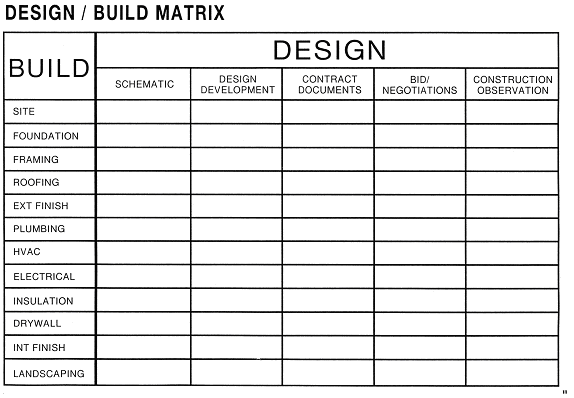
Always design a thing by considering it in its larger context:
a chair in a room, a room in a house, a house in an environment,
an environment in a city plan.
- Eliel Saarinen
For the Owner with an optimistic "can do" attitude, the Design/Build process may seem manageable and indeed it is. The DESIGN BUILD MATRIX illustrates how one might begin to arrange the complexity of information so decisions can be made sensibly and sequentially. This arrangement allows an Owner to focus on one block of information at a time in order to translate the requirements of one's lifestyle into Contract Documents which will direct all activities for the home building project.

For the DESIGN/BUILD MATRIX, there are two dimensions: the DESIGN dimension which sequences the flow of major events for creation of Drawings and Specifications; and the BUILD dimension which sequences the flow of major events during construction. An Ownerbuilder must correlate both dimensions!
As the focus of these two dimensions, the Owner's requirements for the house and site are considered and become more than a tangle of ideas. This is a process of progressive approximation where ideas are presented, problems identified, solutions considered, and decisions refined and finally made. As one concentrates on each block of information, there is a progression towards a final solution which gradually approximates WHAT products and materials will be used for creation of one's homestyle by beginning with vague notions and ending with specific choices.
The Design phase AND the Build phase ARE INTERDEPENDENT taking into consideration the Owner's needs and desires in both written and graphic form. A reasonable amount of time must be allotted to address all aspects for design solutions. The purpose of this section is to provide definitions for the terms used on the DESIGN/BUILD MATRIX.
The Design phase is generally defined as follows:
*Schematic: Define Owner's lifestyle, site conditions, and relevant code and zoning standards; study alternative ideas and cost ranges for each component of the building assembly from site to landscape.
*Design Development: Consider alternatives and sketches most apropos for Owner's lifestyle and site development; investigate more definitive plans, and up-date Budget Estimate for the entire build sequence.
*Contract Documents: Create Drawings and write Specifications through a series of conferences by Owner; prepare documents for code and zoning compliance and building permit application for all components.
*Bid/Negotiations: Prepare Contract Documents for contractor Agreements and Conditions of construction; establish budget guidelines and secure proposals from Trade Contractors and Suppliers for total scope of work to be performed.
*Construction Observation: Check materials and methods at critical points during construction; review Trade Contractor's completion of work and application for payment; up-date design, budget, or products if required by changed conditions. Maintain Quality Control from outset to completion of project.
The Build phase complements the Design phase utilizing materials and products chosen by the Owner and defined by the Drawings and Specifications. Supported by Suppliers, each Trade Contractor completes a major component of the construction project. The Build phase is generally defined as follows:
*Site: Combines geographical location, topography, climate orientation, water, geology, trees and vegetation, views, and noise considerations.
*Foundation: Transfers building loads directly to soil by use of footings, walls, slabs, piers; anchors building to site to avoid racking or uplifting.
*Framing & Roofing: Provides structural elements of floor, wall and roof systems; acts as a barrier to heat loss, moisture and air infiltration; creates aesthetic form.
*Exterior Finish: Includes windows, doors, siding, gutters and downspouts; allows physical, visual, and light penetration; creates stylistic detail.
*Plumbing: Supplies potable and utility water, sanitary drainage, and sewer disposal; trim package contributes to interior decor.
*HVAC: Generates heating, ventilation, and air conditioning systems; trim package and vent caps lend to decor.
*Electrical: Distributes energy for light, heat, and operation of appliances and equipment; trim package adds to interior design; services installed for television, telephone, security, and office.
*Insulation: Controls heat loss or gain in floors, walls, and ceilings; weatherizes doors, windows, and sills; offers sound deadening for interior spaces.
*Drywall: Covers interior walls and ceilings for finishes and fireproofing; texture and corner trim contribute to decor package.
*Interior Finish: Establishes color, texture, pattern, and scale of interior design motif; includes paints, doors, hardware, trim, closet kits, cabinets, floor coverings.
*Landscape: Arranges vegetation, walks, drives, lighting to marry house architecture to site; allows drainage of storm water; places gazebos, decks, patios, summer kitchens, gardens for climate orientation and lifestyle.
A good way to begin using the Design/Build Matrix is to label manila files with the eleven categories of the Build Phase. As you consider different aspects of each of the Build events, you should place notes, drawings, and ideas into each respective manila file. It's a process of considering your options, refining your thinking, and making a choice among the range of alternatives open to you. Don't try to finalize decisions.
Remember: this is a process of progressive approximation.

Once you've initially reviewed the major events of the Build phase, you'll feel more confident with your original ideas and begin to weigh and consider alternative ideas. Your Schematics are based on considerations such as code and zoning standards, costs, lifestyle requirements, and aesthetic quality. Your manila files will begin to bulge with ideas and the "Design/Build Collage" (Read more about the "Design/Build Collage" in the PUNCH LIST section) will unfold as an artistic endeavor.
You'll start over again as you refine ideas gathered for each of the Build events and progress into Design Development. More than likely you'll be creating additional manila files to expand your growing information base. For instance, your "Exterior Finish" file may be expanded into separate files for windows, doors, siding, and storm water control (Read more about the "Cardboard Box Files" in the PUNCH LIST section). Your original ideas become more definitive plans and the Budget Estimate becomes more accurate.
At this point your homestyle should be clearly defined, and you're now ready to create Contract Documents. Depending how adept your drafting and writing abilities, it may become especially important to retain the professional services of a Construction Manager, Architect, or Designer if required by your situation. The creation of Drawings and Specifications are crucial to code compliance and successful building permit application so be prepared for a collaborative effort.
For Bid/Negotiations to occur, the Owner must have ample copies of Drawings and Specifications in hand to circulate among Trade Contractors and Suppliers in order to solicit their bid proposals. Depending on how skillful your legal and negotiating abilities, the Owner might consider the professional services of a Construction Manager, Lawyer, and Accountant if required by your situation. The preparation of Agreements and Conditions for the work to be performed will refine your Budget Estimate and begin to determine who will provide labor and materials for your project.
Although there's always room for improvement, you should realize any major changes or deviations may cause financial and logistical problems as you move into Construction Observation. Quality Control involves checking materials and methods as each phase is completed but changing conditions may cause the Owner to up-date the design, budget, or products. Your lending institution will require on-site review of construction in order to authorize payment for work completed, and formal inspections by building officials will also occur at critical points in the schedule.
Use this Design/Build questionnaire to begin your action plan:
- Is your lot buildable according to local, city, state, and federal guidelines?
- What are the dimensions and topography of your site?
- Are there special site features to incorporate in the landscape design?
- Do any distinctive geological, meteorological, or biological conditions exist?
- Are there unique soil or structural conditions which require engineering?
- How will utility infrastructure be developed to and on site?
- Where will driveway access and parking be located?
- Why do you prefer a certain architectural style?
- Do you anticipate specific square footage and cost range?
- Is a one or two story home preferred, and do you require a basement?
- What roofing material will be used, and what is the color and texture?
- How will the exterior be covered, trimmed, and treated?
- What are your preferences for door and window styles?
- Will the garage be detached or attached to your home?
- Where will you locate sidewalks, patios, decks, and porches?
- During construction will site traffic and material pose problems?
- Where are temporary water and power as well as job toilet to be placed?
- How will you enter/exit the home, and do you require a foyer?
- Will the living room be formal or informal, and how will it be used?
- Will the dining room be formal or informal, and how will it be used?
- Will the kitchen be formal or informal, and how will it be used?
- Will your family use an outdoor eating area off the kitchen?
- Will your family room be open to the kitchen or separate from it?
- Is there a need for a study, home office, hobby room or other special area?
- How many bedrooms are required, and where will they be located?
- How many bathrooms are required, and where will they be located?
- What is the total number of plumbing fixtures, and who are the manufacturers?
- What is the means of heating/cooling your home, and who is the manufacturers?
- Where will you need electrical outlets, switches, lights, fixtures?
- What are the specific requirements for weatherization and insulation?
- Will the drywall be textured, and what will be interior color schema?
- What is the total number and types of appliances, and who are the manufacturers?
- What is the aesthetic nature of trim package by style, color, and finish?
- What floor coverings will be used, and how will style/color match decor?
- What style, color, and configuration of cabinets do you want?
- How will landscape be designed and implemented?
- Who will be responsible for site clean-up and waste recycle?
Keep in mind that corrections or "fine tuning" is always necessary as you progress from schemas, design development, contract documents, bid/negotiation, and construction observation. It's highly unlikely every detail will be determined at the outset for all the Build categories. Good advice is to be a stickler for detail yet allows you the freedom to make some decisions later realizing that this "fine tuning" is accepted as part of the Design process.
Let the Design/Build Matrix be a map to guide you through this process.
|





